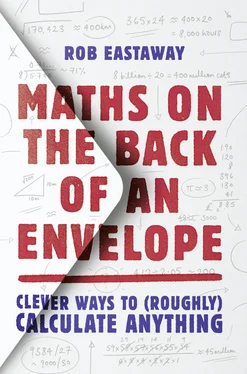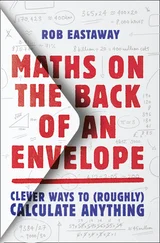What could possibly go wrong?
A tourist in a natural history museum was very impressed by the skeleton of a Tyrannosaurus Rex.
‘How old is that fossil?’ she asked one of the guides.
‘It’s 69 million years and 22 days,’ said the guide.
‘That’s incredible, how do you know the age so precisely?’ asked the tourist.
‘Well, it was 69 million years old when I started working at the museum, and that was 22 days ago,’ replied the guide.
The thoughtless precision of the museum guide in this old joke nicely illustrates why there is no point in stating a number to several figures if the overall measurement is only a rough estimate. Yet it is a mistake that is made time and again when presenting and interpreting numbers in everyday life.
Quoting a number to more precision than is justified is often called spurious accuracy, though it should really be called spurious precision and we will encounter it several times in this book. It is one of the strongest arguments against the unthinking overuse of calculators. The fact that you can work out numbers to several decimal places at the touch of a button doesn’t mean that you should .
PRECISION VERSUS ACCURACY
The words precision and accuracy are often used interchangeably, to indicate how ‘right’ a measurement or number is. It is certainly possible for a number to be accurate and precise; for example: 74 × 23.2 = 1,716.8.
But used mathematically, precision and accuracy mean different things.
‘Accuracy’ is an indication of how close you are to the right answer. Suppose we are playing darts. I throw a dart at a dartboard and just miss the bullseye. My throw was quite accurate, but if you then throw and hit the bullseye, your throw was more accurate than mine. Likewise … if I tot up the items in my shopping basket and estimate that the total will be £65 while you reckon it will be £70, and the bill turns out to be £69.43, then you were more accurate than I was.
Precision, on the other hand, is an indication of how confident you are in a number to a particular level of detail, so that you or somebody else would come up with the same figure if you did a measurement or calculation again. If you think the shopping basket will add up to £69, you are confident that you are right to the nearest pound; but if you suggest the bill will be £69.40, you are being more precise, and are confident your figure is right to the nearest 10 pence. Even more precise is £69.41. In maths terms, precision is about how many significant figures (this is an important concept – please see here) you can quote a number to.
As a society, we put a lot of faith in precision. If we see a number such as 84.36, we tend to believe that the person who produced the number is confident of that figure to the second decimal place. We might even honour them with the label of ‘expert’ because they were able to produce a number to such precision. But people who produce ‘precise’ figures often abuse our trust, and accidentally or deliberately they imply a level of confidence that is not justified. When we read that 59,723 people attended an Arsenal football match, we are being led to believe that an exact tally was taken as fans went through the turnstiles. So when we discover that the actual number in the ground was closer to 50,000, we feel like we have been conned. 3
When it comes to the use of numbers to interpret the world, accuracy is more important than precision. After all, a measurement that is accurate but not precise can still be helpful. But a measurement that is precise but inaccurate is not just unhelpful, it can sometimes be dangerous.
One of the unintended consequences of calculators is that they will give answers to as many decimal places as will fit on the screen – and in doing so, they tempt us to work to a level of precision that is often not justified.
DRESSING UP NUMBERS WITH DRESSAGE
In 2012 London hosted the Olympics. People throughout Britain celebrated as gold medallists stepped up on the podium in all sorts of sports in which previous GB athletes had rarely excelled.
There was particular joy when Charlotte Dujardin, who had worked her way up from being a stable girl to becoming an elite equestrian, claimed Britain’s first ever gold medal with her horse Valegro in the dressage event.
Dujardin’s winning score from the judges was an impressive 90.089%.
Sportspeople often talk about ‘giving it that extra ten per cent’, but in this case it seemed as if Dujardin had fine-tuned this, so she could put in that extra 10.001%. What was it that made her performance better than somebody who got, say, 90.088% instead?
To understand where her three-decimal-place score came from, we need to look at how the judges allocated marks in that competition.
In the dressage event at the London Olympics, the competitors were required to take their horse through a series of movements, which would be assessed by seven judges seated around the arena so they could view from different angles. The judges were scoring under 21 headings: 16 of them were ‘technical’ marks given for how well specific movements were carried out, and five of them ‘artistic’, applying to the overall performance, with descriptions such as ‘Rhythm, energy and elasticity’ and ‘Harmony between horse and rider’ (yes, really).
Each item was marked out of 10, with half-marks allowed, but some scores were then given more weighting, and the five artistic scores were all multiplied by four. In total, each judge could give up to:
240 technical marks + 160 artistic merit marks
= 400 marks total.
It meant each rider had a total of 7 × 400 = 2,800 points to play for.
There is an element of subjectivity when assessing how good a horse’s performance has been, so it is hardly surprising that the judges don’t all give the same mark. For a particular technical movement, one judge might give it an ‘8’, while another spots a slightly dropped shoulder and reckons it’s a ‘7’. In fact, in Dujardin’s case, the judges’ total marks ranged from 355 to 370, and when added together she got a total of 2,522.5 points out of a maximum possible 2,800.
And this is where the percentage comes in, because her 2,522.5 total was then divided by 2,800 to give a score out of one hundred, a percentage:
2,522.5 ÷ 2,800 = 90.089%. 4
Well, actually that’s not the exact number. It was really 90.089285714285714 … %.
Indeed, this number never stops, the pattern 285714 repeats for ever. This is what happens when you divide a number by a multiple of 7. So Dujardin’s score had to be rounded, and the authorities who were responsible for the scoring system decided to round scores to three decimal places.
What would have happened if Dujardin had been awarded half a mark less by the judges? She would have scored:
2,522 ÷ 2,800 = 90.071%.
In other words, the precision of her actual score of 90.089 was misleading. It wasn’t possible to score any other mark between 90.089% and 90.071%, Dujardin didn’t give it an extra 0.001%, but rather she gave it that extra 0.018%. Quoting her score to two decimal places (i.e. 90.09%) was enough.
The second decimal place is needed to guarantee that two contestants with different marks don’t end up with the same percentage, but it still gives a misleading sense of the accuracy of the scoring. In reality, each judge ‘measures’ the same performance differently. A half-mark disagreement in the artistic score (which is then multiplied by 4, remember) shifts the overall mark by 0.072%. And the actual discrepancies between the judges were bigger than that. For ‘Harmony between horse and rider’ one judge marked her 8 out of 10 while another gave her 9.5 out of 10.
Читать дальше












